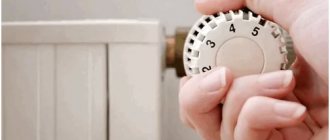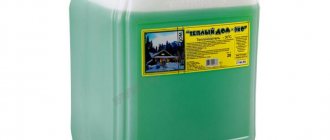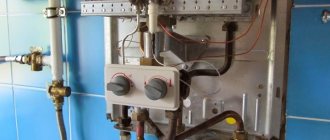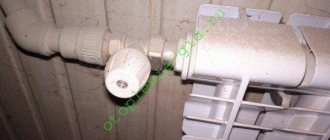Heating cannot be classified as the simplest device. Its work is based on various physical laws; the system uses devices and mechanisms of various functional purposes, and to obtain the desired result it is necessary to ensure their coordination with each other. One of the features of water heating is an effect called water hammer in the heating system - a sharp, albeit short-term, increase in pressure in the system.
Abrupt manipulations with shut-off valves - opening or closing - lead to an instant change in pressure in the device area. When closing, the pressure on the valve and its connecting elements increases. In this case, seals of threaded connections, wafer gaskets, and, at high pressure, elements of the shut-off device are often damaged. When opening quickly, there is a low pressure area in the area behind the valve. The liquid instantly rushes into it, acquiring greater speed. In this case, elements located after the reinforcement are subject to destruction. Areas with high hydraulic resistance are especially susceptible to water hammer - bends in pipelines, heating devices (radiators, convectors, etc.).
How to open and close the battery correctly? In what order?
Water hammer occurs when steam enters water. Since dangerous steam heating has not been used in residential premises for a long time, I dare say that you have nothing to fear. However, in any case, it is wiser to first shut off the flow of water into the battery, and only then its exit from the battery. Well, there is no point in keeping high pressure in your own battery, the integrity of which depends precisely on the pressure.
How long does the air come out of the battery?
Air usually comes out from one battery within 5 - 7 minutes. It sometimes takes half an hour or more to de-air the entire system.
Interesting materials:
How to find out your Beeline short number? How to find out your Steam account number? How to find out your ICQ number if you forgot? How to find out your education document number? How to find out your Google Voice number? How to find out your Yandex wallet number? How to find out your IBAN number? How to find out your tax identification number via the Internet? How to find out your personal account number in Energosbyt Tyumen? How to find out your number on a beeline modem?
Types of radiator taps
As a rule, taps of various types and designs are installed in front of the entrance to the battery (radiator). This is done so that in the event of an unexpected radiator leak, it does not shut off the entire system, but stops the water supply to the specific damaged area. And also to prevent leakage of liquid from the batteries during centralized heating. Moreover, the taps are installed both at the inlet and at the “return” (that’s 2 pieces per battery). It is recommended to use the same type of taps of the same design. The main design options are as follows:
- Valve
- Ball
- Thermal head
Each type of crane has its own advantages and disadvantages. And also radically different designs and preferred installation locations. But they have one purpose: to stop or ensure the supply of working fluid to the radiator. The use of different types of shut-off valves depends on the design of the heating system itself, the type of radiators, and installation locations.
Methods for sealing connections
If the thread profile does not have a sharp edge, FUM tape can be used as a sealant. However, this modern material has not caught on among experienced specialists; they consider flax to be the most reliable sealant. A thin strand of this material, collected into a bundle, is wound around the pipe, starting from its end. The winding direction should be opposite to the thread direction. The flax should fill the thread to its full depth, and each new turn should partially overlap the previous one. The seal will be more reliable if the thread is equipped with a notch that prevents the flax winding from turning. Before installation, the threads of the part should be coated with UniPak packaging paste or similar.
Installation on polypropylene pipes using adapter couplings.
If the heating system is made of polypropylene pipes, then metal ball valves on the heating radiators are installed using adapter couplings. All threaded connections in this case are sealed according to the method described above.
Mayevsky taps are often equipped with a gasket made of rubber or other material, so they do not need to seal the FUM with tape or tow.
When the installation or replacement of all shut-off and control valves has been completed, it is necessary to perform a test run of the system. This will make it possible to check the tightness of all connections and the functioning of the valves under operating conditions. In this case, it is important to make sure that the system is completely de-aerated and the working medium circulates normally in it. A small amount of sealing material should be added to threaded connections that are found to be leaking.
Why can batteries heat poorly? The main reason for insufficient heating of radiators is the appearance of air in them. It was for this purpose, more than eighty years ago, that a special device was invented for removing air from radiators and heating pipes - the Mayevsky tap (or Mayevsky valve).
Adjustment during installation and beginning of the heating season
The initial adjustment of heating radiators in an apartment should be carried out at the installation stage. In particular, in order to prevent the formation of air pockets, radiators are mounted with a slight slope (height difference 3-4 mm) towards the riser and supply pipe. On the other hand, a Mayevsky tap is installed at the top of the battery, with the help of which air is removed. In addition, at the end of the heating season, when water is removed from the system, a slight slope will ensure complete drainage of water from the radiators.
At the beginning of the heating season, if the risers are already hot, but part of the battery does not heat up, then an air bag has formed in the device, interfering with the normal circulation of the coolant. In this case, the air removal procedure is performed using a flat screwdriver. The Mayevsky tap is slowly unscrewed with a screwdriver until all the air comes out and water appears.
The need to disconnect
Before moving on to the diagram for disconnecting the battery from the riser in an apartment building, we suggest considering the basic reasons that can cause a malfunction of the heating system.
Here is a list of the most likely reasons for a battery disconnection:
- an emergency situation that threatens to flood your and your neighbor’s apartment with hot coolant;
- painting radiators in the cold season, when the heating is already on;
- if there is a need to change the radiator or flush it;
- In winter, the radiators are too hot and you want to lower the room temperature.
In some apartments, residents practice shutting off radiators in the summer without draining the coolant in order to protect radiators from blockages when the heating system is turned on in the fall. At this time, water often flows through the pipes with rust fragments. We will tell you how to do this correctly in one of the sections of this article.
Installation of air vents
A typical tap for a radiator is a product by Mayevsky. The faucet is a simple structure made of a brass rod, which in the closed position covers the hole in the seat, and threads to install it in the radiator plug (for more details: “What is the Mayevsky valve needed for - features of use, characteristics”).
Such taps for heating radiators are reliable and rarely require repair or replacement, but:
- their cross-country ability is low. If you put the faucet on the riser and wait about 10 minutes once a year until the air comes out easily, then it is hardly worth installing such an air vent on the expansion tank of an apartment building with top filling. It is better to give preference to a conventional valve;
- when buying a Mayevsky faucet, you need to choose a product for a screwdriver, and not for a special key, which cannot always be quickly found before starting the heating;
- Some products of this type allow you to unscrew the rod completely; unfortunately, such cases are not uncommon. No one has yet succeeded in screwing the rod into place, overcoming the resistance of the hot coolant.
An alternative to the Mayevsky tap is a drilled radiator plug or an adapter with a screwed-in plug valve. Sometimes, for this purpose, a regular water tap is used, which is placed in an inverted position - with the spout up.
When installing a tap on a heating radiator in this way, you need to remove the handle and knob from the valve, since a small child in the house will be attracted to a bright object, and he will eventually try to turn it. The consequences will be unpleasant.
Recommendations
Sometimes, due to various reasons, it becomes necessary to replace radiators, pipes, fittings, and shut-off valves of the heating system. After all the work done (installation, wiring, crimping, etc.). As a rule, in centralized heating systems, high water pressure is supplied during the initial check. Which will lead to leaks if assembled poorly. If possible, you need to be at home and check for leaks in all connections, including valves and thermal heads. These are the most vulnerable places due to poor quality assembly.
In the event of sudden leaks in individual heating systems, it is always possible to turn off the boiler and shut off the coolant supply. With centralized heating, everything is much more complicated. You'll have to call a locksmith from the housing office. Shut off the heat supply to the entrance. The classic wiring option provides for the supply of coolants with the possibility of shutoff to each entrance separately.
It is necessary to purchase shut-off valves and components from trusted suppliers. Replacing a thermal valve is considered an expensive option for plumbing services. The main thing before installing any type of shut-off valves is to consult with a specialist which type of valves may specifically suit your heating scheme.
Risers and valve that cuts off heating areas
The recommendations of specialists in this case do not differ in the originality of the solution, since plug valves are considered the best choice. It is necessary to create conditions in the risers for discharging the coolant liquid and plugs are chosen for this purpose, but they are not always convenient, since it will be quite problematic to unscrew the plug on the supply riser, through which a water flow with a water temperature of about 90 degrees circulates.
As a result, the conclusion is obvious: valves should be installed to discharge the water.
In this situation, you can use screw devices, since they will not have significant disadvantages:
- if the oil seal is installed correctly, it will not have contact with the water flow under pressure;
- water hammers become impossible, since the valve is mostly closed;
- To replace the gaskets, you do not need to reset the entire house system - it will be enough to stop the riser.
Who to entrust the work to?
Since you will still have to pay, it is better to do everything at once. In any case, with all the radiators on one riser. And here the question arises: who will carry out this work. To get started, you can go to the housing office or departmental office and ask about their prices. As a rule, the prices there are rather high, and the quality of work is not up to par. To make sure of this, you can ask neighbors who have already dealt with them.
You can find a private owner. Just not from advertisements, but from the recommendations of acquaintances, colleagues, friends. Their prices are rarely higher than those of operators. And the quality is better - this is their bread: if they do a bad job, there will be no customers. That’s why they try (if they are sane) to do everything conscientiously.
Choosing a performer is not an easy task
There is still an opportunity to negotiate with the housing office employee by bypassing the cash register. But here the option is controversial. Firstly, they tend to ask for a price based on the client’s wealth and it is far from a fact that they will demand less than the price list. More likely - more. Why, tell me, should they pay more for the same quality of work (it is unlikely that they will work more diligently than at their main job)?
Another option is to contact a specialized organization. And again, preferably based on recommendations. Although, organizations are forced to monitor the quality of work for prosaic reasons: they need clients. If they have a bad reputation, no one will go to them
Therefore, if you don’t know the organization, there are no recommendations, you can pay attention to the period of its existence on the market. If it’s not a year or two, then they definitely know how to do something, otherwise they wouldn’t have existed for so long
Naturally, pay attention to the services they provide. Many people suggest that issues with permission and disconnection of risers should be handled by the management or operating organization. You just specify the list of works and time. How expensive will it cost? In different ways: organizations, like their leaders, are different. It may be more expensive than the work of a mechanic from the housing office, but at least you will have someone to file a claim with in case of problems: you sign an agreement that will clearly outline who is doing what.
And the most economical option: do everything yourself, with your own hands. It’s not an easy task, but it’s not the gods who burn the pots. Just first you need to find out everything down to the smallest detail, purchase everything you need, prepare tools and equipment, and only after that write an application to turn off the riser.
Methods for sealing connections
If the thread profile does not have a sharp edge, FUM tape can be used as a sealant. However, this modern material has not caught on among experienced specialists; they consider flax to be the most reliable sealant. A thin strand of this material, collected into a bundle, is wound around the pipe, starting from its end. The winding direction should be opposite to the thread direction. The flax should fill the thread to its full depth, and each new turn should partially overlap the previous one. The seal will be more reliable if the thread is equipped with a notch that prevents the flax winding from turning. Before installation, the threads of the part should be coated with UniPak packaging paste or similar.
Installation on polypropylene pipes using adapter couplings.
If the heating system is made of polypropylene pipes, then metal ball valves on the heating radiators are installed using adapter couplings. All threaded connections in this case are sealed according to the method described above.
Mayevsky taps are often equipped with a gasket made of rubber or other material, so they do not need to seal the FUM with tape or tow.
When the installation or replacement of all shut-off and control valves has been completed, it is necessary to perform a test run of the system. This will make it possible to check the tightness of all connections and the functioning of the valves under operating conditions. In this case, it is important to make sure that the system is completely de-aerated and the working medium circulates normally in it. A small amount of sealing material should be added to threaded connections that are found to be leaking.
Shut-off and control valves, which are often called taps in everyday life, are the most important part of any heating system. Errors when choosing or installing these devices very often are not limited to a deterioration in the performance of the heating system, but lead to emergency situations with very tangible consequences. Hot water gushing out with strong pressure from a burst or broken faucet will have time to cause considerable damage while the system is completely turned off, and in the worst case, it can result in burns and other injuries. Therefore, the selection, installation and operation of fittings should be approached very carefully. We'll talk about how to do all this correctly.
How to open a ball valve
A ball valve refers to elements of shut-off valves that prevent adjustment of liquid pressure at any pressure. Its main task is to completely block the flow of liquid or vice versa. If the ball is not closed or opened sufficiently (until the lever stops), wear occurs on the ball, which quickly leads to its breakage.
How to correctly determine the operating condition of a ball valve. The design itself provides for the use of an L-shaped lever, about 10 cm long, as a handle. This is done so that the user does not apply much effort when turning the lever. Attention, when the lever is installed along the water pipe, the tap is open (water flows into the radiator). If the lever is perpendicular to the pipe, this is a closed position (no fluid flows into the battery).
Ball valves are often used in "passive" applications. Usually this is a drain, on batteries, to release air. Or central coolant supply in individual heating systems.
How to adjust the thermal head
This type of fitting can be called the most popular invention for heating systems. The thermal head (thermal valve) is intended to regulate the heating temperature. It allows you to rationally use heat and, accordingly, increase payment savings. The classic version of the device includes the following elements:
- frame;
- bellows;
- locking element;
- shut-off rod (cone);
- return spring;
- sealing rings with fasteners;
The thermal valve itself is a valve device, which, in fact, regulates the flow of coolant into the radiator. There are three types of shut-off and adjustable valves of this type: Manual, mechanical, electronic options.
The manual version has an adjustment knob on the body to set the temperature with a scale. Comfort mode is selected by turning the knob to the right or left. Frequent adjustment is not recommended. Otherwise, rapid wear of parts will occur followed by breakdown.
Typically this element is used on cast iron batteries.
This type of shut-off valve can be called a substitute for a ball valve. Like a faucet, a thermal valve performs the functions of closing or opening the coolant supply to the battery. The difference lies in the ability to set the specified temperature. Which will be maintained at a stable pressure in the pipeline network. The advantage of this thermal valve is its relatively low cost and simplicity of design. The disadvantage should be noted that it is short-lived with frequent adjustments.
The mechanical designs of thermal heads have an advanced system and can regulate heat automatically. For example, if, in the case of manual adjustment, the temperature in the system increases, then it also increases in the room. The mechanical type of thermal valve, when the set mode is increased, locks the flow of hot water into the battery, thereby maintaining the set temperature mode. Adjustment occurs by turning the lower part of the housing according to the indicated marks.
The electronic thermal head also operates in automatic mode. It has external differences in the form of an electronic display and push-button control. It is recommended to install on foreign-made radiators. Experienced plumbers advise installing the thermostat housing horizontally outwards. To ensure proper compliance with operating conditions.
Electronic thermal head
In frequent cases, in order to avoid damage when cleaning or walking near batteries, the device is installed with the head up, or even in the battery niche. This cannot be done. Correct operation does not occur, and accordingly, the set temperature parameters are adjusted. You should also not install the thermostat near window sills. A draft from a window will lead to incorrect operation modes.
Important information. In single-pipe heating systems, when using a thermal head, it is necessary to install a bypass. Strictly speaking, this is a piece of pipe 1 size smaller than the supply. It is installed in the idea of a jumper between the supply and return.











